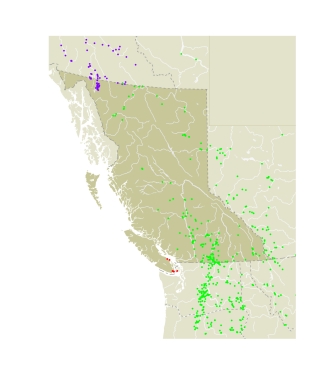Large Marbles have only one brood in BC, which is in flight in May and June at low elevations, and as late as early August in alpine habitats. In California eggs are laid exclusively on the flower buds of Brassicaceae (Opler 1975). This exclusive use of flower buds is so complete that Shapiro (1985a) explicitly noted how unusual was one egg laid on a small leaf adjacent to an inflorescence. In California the eggs are seldom laid on plants less than 1 m high (Shapiro 1981a), and first instar larvae die if fresh unopened flower buds are not available for them to feed on when they hatch (Opler 1975). Young larvae position themselves vertically between flower buds and cover the inflorescence with loosely spun silk (Opler 1975). In contrast, in BC oviposition by Large Marbles is normally on leaves in various positions along the stem of Arabis, from near the ground to near the top of the stem. Early in the flight season, subspecies ogilvia lays eggs primarily on Arabis flower buds, but later in the season eggs are laid on the leaves and stems. Stems at the time of oviposition may all be less than 0.5 m in height, or near 1 m, depending on the population. Larvae feed on the leaves when young, and move to the seed pods as they mature (CSG).
All larval foodplants are in the family Brassicaceae, primarily Arabis in BC (CSG). Outside BC food plants include Arabis drummondii, Afendleri, A. glabra, A. hirsuta, Alyallii, A. suffrutescens, Barbarea vulgaris, B. orthoceras, Berteroa incana, Brassica campestris, B. kaber, B. nigra, B. vulgaris, Oescurainia incana, O. californica, Oraba nemorosa, Erysimum asperum, Hirschfeldia incana, Isatis tinctoria, Lepidium, Raphanus sativus, Sisymbrium altissimum, and S. officinale (Shields et al. 1970; Shapiro 1981a, 1974b; Howe 1975; Opler 1975; Shapiro et al. 1981; Scott 1992; Bird et al. 1995).
|
